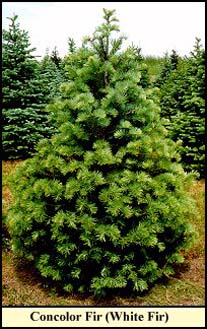
Concolor (White) Fir
Abies concolor (Gord. and Glend.) Hildebr.
Description
White fir, also commonly called concolor fir, is native to the western United States and may reach sizes of 130-150 ft. in height and 3 to 4 ft. in diameter. The oldest white firs may occasionally reach 350 years of age. It produces a spire-like crown with a straight trunk.
On older trees, the lower on-half to one-third of the crown is often free of branches.
Leaves (needles) are small and narrow and occur in rows. On upper branches, needles tend to be thicker and more curved than those on lower branches. Needles are usually 1/2 to 1 1/2 inch long, pointed or notched at the tip, bluish-green when young turning dull green with age. Typically, they are flat, without stalks.
The bark on younger trees is thin, smooth, gray with numerous resin-bearing pockets. Older bark is thicker, reddish-brown to light gray and broken into irregular, flattened scales.
Both male and female flowers (strobili) are found on the same tree. Pollination occurs in the spring and cones mature in one season. Cones are barrel-shaped, about 3 to 6 inches long, and mature in early fall. Cones are upright and generally disintegrate after seeds are shed. Good seed crops occur at 2- to 4-year intervals.
White fir is tolerant of a considerable amount of shade. Its best growth is on moist loamy soils, but may often be found on dry, thin soils. The species seldom occurs in pure stands but grows in association with numerous other species depending on location and elevation. White fir is commonly found with Douglas-fir, sugar pine, ponderosa pine, and red fir.
White fir is severely damaged by mistletoe. Leaves of white fir are often attacked by spruce budworm and Douglas-fir tussock moth. Bark beetles may also be a serious problem in some areas.
As a Christmas tree, white fir has good foliage color, a pleasing natural shape and aroma, and good needle retention.
Range
White fir has one of the largest ranges of any of the commercial western firs. It can be found from the Rocky Mountains in Colorado and New Mexico to the Coast Range in California and Oregon. White fir occurs from 6000 ft. to 11,000 ft. in elevation in the Rocky Mountains and as low as 2300 ft. near the Pacific Coast. Differences in habitat as well as growth requirements and morphological characteristics have led some authors to propose the separation of white fir into two taxonomic varieties, one in the Rocky Mountains and the other in the western part of the species’ range.
Propagation
Most propagation is by seed, although both rooting and grafting has been successful. Most vegetative propagation has been to increase the number of rarer forms. Several cultivars have been propagated including a weeping white fir sold under the name of Abies concolor `Pendula’.
Uses
White fir is an excellent ornamental tree and is widely planted in the eastern United States and Canada. It is often used in cemeteries as a contrast to darker-colored evergreens.
The wood of white fir is light, soft and coarse-grained. Its primary uses have been for pulpwood, lumber, furniture, and boxes and crates. Because the wood lacks a distinctive odor, it was used in earlier times for tubs in which to store butter.
White fir is important to many species of wildlife. Blacktail and mule deer feed on the buds and leaves during the winter, porcupines eat the bark, and Douglas pine squirrels are fond of the seeds. Grouse may also eat seeds after they fall from the cones.
Prepared by Dr. Craig R. McKinley, North Carolina State University
